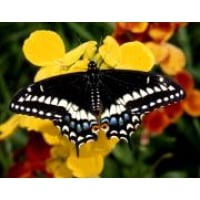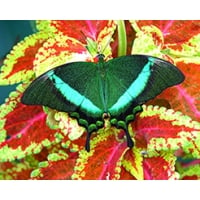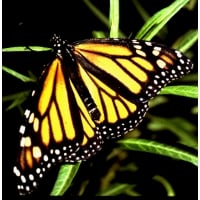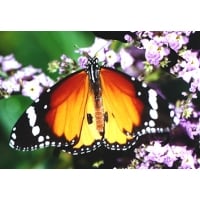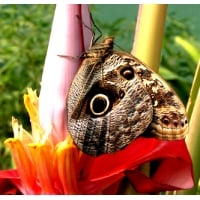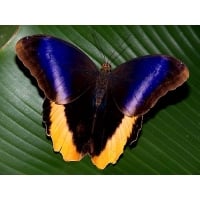EXOTIC BUTTERFLY PUPAE
It looks like you are ordering Internationally from United States, Please note below:
EXOTIC BUTTERFLY PUPAE
Most exotic pupae emerge quite quickly. For international orders, post takes too long, so fast-developing pupae are sent by XXP Express courier. Delivery in Europe is usually next day after dispatch, or soon after. Express courier usually delivers everything very fresh and in the peak of condition.

Exotic Butterfly Pupae Incredible shapes, colours, markings, knobs, metallic reflections. Such diversity only nature could invent.
The pupae are as different and exciting as the wonderful butterflies they produce.
IMPORTANT - Please read this guide to hatching of exotic butterfly pupae:
Provide warmth and humidity that the pupae normally experience in the tropics. About 30°C is ideal, and humidity above 70%. The butterflies like a warm greenhouse containing varied plants, especially those producing nectar flowers to feed from, and this is the best place also for the emerging cage for the pupae. Examples of nectar flowers include Ixora, Buddleia, Pentas, Eupatorum, Clerodendrum and most Asteraceae (formerly Compositae). Shade the cage from direct sun, which is too harsh. If you don’t have such an environment, you may be able to simulate a warm and humid atmosphere in another way, but don’t apply direct heat. The whole incubation cage needs to be in an even temperature and humidity, which is best provided in a tropical greenhouse environment. It is usually beneficial to mist the pupae at several times a day. It is normal in nature for night to be cooler than day.
It’s a good idea to suspend the pupae. To do this, use a cane held horizontally. Apply a very thin line of contact adhesive eg Evostick along the cane. Lay the cane on a table and, when it is tacky but not yet set hard, touch the tails of the pupae on the line of glue. Warning: excess glue actually kills the pupa, so use just a very thin line. When the glue has set you can pick up the cane, with all the pupae hanging by their tails from it.
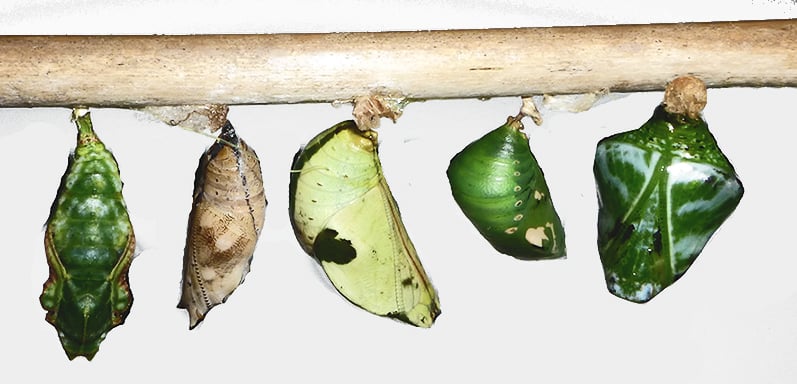
Pupae of the Swallowtail and Pierid families don’t hang from the tail (cremaster), head downwards. They are attached to a twig at the tail, and they use a silk sling around the wing cases to anchor themselves, head upwards and at an angle away from the twig. To simulate this, you can take some lengths of cane. Make a thin line of glue as described above. Lay the cane on a table, then attach the tails of the pupae to the glue line, and touch the abdomen also against the glue line. Once dry, the cane can be arranged standing at an angle against the sides of the emerging cage, or you can arrange them stuck into a block of florist’s foam. There needs to be enough space to allow the emerging butterflies to climb up, expand and dry their wings.
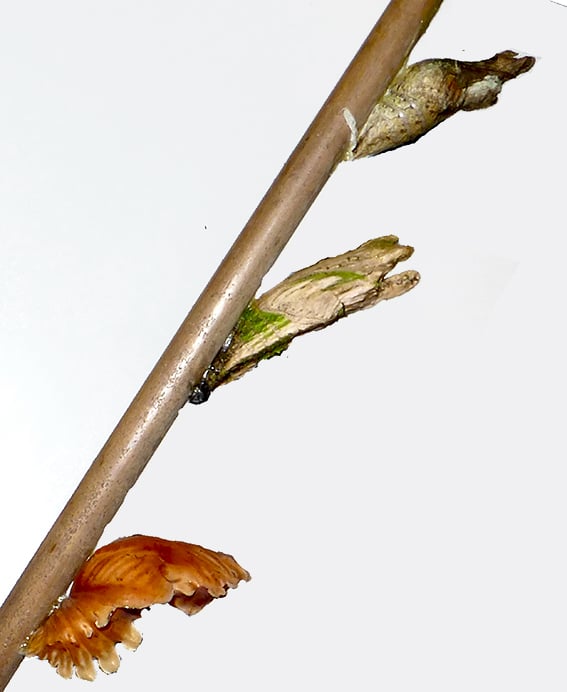
Usually fixing the pupae to a cane helps to give hatching butterflies the best foothold. When fixed to canes pupae are very exposed and can easily dry out. Mist them several times a day. If you don’t wish to glue the pupae to a cane, they can be laid out on corrugated card or other rough surfaces, such as bobble foam, flat on the bottom of the emerging cage. See PUPAE NEST on this website. This material will help to keep the pupae moist if you spray them at least once a day. For hygiene the material needs to be cleaned or replaced every few days.
Resulting butterflies do well in a tropical greenhouse, planted with lush greenery and copious nectar-bearing flowers. Some species like to feed from over-ripe fruit. They may live 2-4 weeks in such conditions, exceptionally they can live longer. Kept in a cage in a house, their life may be just a few days, but sometimes longer if they are given fresh nectar flowers each day, and misted to prevent the atmosphere becoming too dry. Non-native butterflies must not be released.
Black Swallowtail Papilio polyxenes asterias North America
Very closely related to the European and British swallowtails, asterias will often hybridise with either, producing interesting offspring.
The collections of 4 pupae comprise 3 male and a female pupa for breeding.
The larvae feed on Fennel, Carrot tops, and some other Umbelliferae including wild and probably cultivated Parsnip. Two broods are produced in the year and the pupae of the second brood hibernate.
The Giant Swallowtail Papilio cresphontes North America
This is North America's largest butterfly. An impressive broad-winged Swallowtail as fine as any tropical species. The Giant Swallowtail will breed in captivity. The larvae, which are knarled and resemble a bird dropping, feed on Rutaceae: Citrus, Rue and probably Choisya, as well as Zanthotoxylum.
WORLD SWALLOWTAIL PUPA COLLECTION 10 pupae
These are unidentified, very varied in shape, size, colour and pattern. They are mostly tropical or sub-tropical and for emergence provide warmth and humidity that the pupae normally have in their natural environment.
These are some of the loveliest butterflies of all butterflies. They come, unlabelled, ready to emerge and surprise you. Some may form up and emerge within a few days, others may take a month or more. When possible ten different species will be supplied.
Photos on this site are representative and, as there are so many species, your collection may have any of the possible species, not necessarily those illustrated.
World Collection of Exotic Butterflies
From several world regions and families. Un-identified, selected for beauty and interest. The pupae alone are things of great beauty and interest. One of the real joys of nature!
Choose between the STANDARD World Collection and the DE LUXE World Collection. Both are varied and interesting. The DE LUXE includes such beauties as the shimmering blue Morpho, Giant Owl Butterflies, Larger exotic Swallowtails, Iridescent blue banded Prepona and the like. The pupae are usually larger and some very intricate. Well worth the difference in price. Some species develop in the pupa quite fast, which is why for international orders it is essential to send by courier, though this does not guarantee safe arrival, particularly in summer and to hot countries. in cooler months pupae usually arrive safely.
Illustrations are representative: yours may not be these species as there are so many to choose from - good value is always assured. When possible 10 different species will be sent though this is not always possible.
IMPORTANT - Please read this guide to hatching of exotic butterfly pupae:
Provide warmth and humidity that the pupae normally experience in the tropics. About 30°C is ideal, and humidity above 70%. The butterflies like a warm greenhouse containing varied plants, especially those producing nectar flowers to feed from, and this is the best place also for the emerging cage for the pupae. Examples of nectar flowers include Ixora, Buddleia, Pentas, Eupatorum, Clerodendrum and most Asteraceae (formerly Compositae). Shade the cage from direct sun, which is too harsh. If you don’t have such an environment, you may be able to simulate a warm and humid atmosphere in another way, but don’t apply direct heat. The whole cage needs to be in an even temperature and humidity, which is best provided in a tropical greenhouse environment. It is usually beneficial to mist the pupae at least once a day. It is normal in nature for night to be cooler than day.
It’s a good idea to suspend the pupae. To do this, use a cane held horizontally. Apply a very thin line of contact adhesive eg Evostick along the cane. Lay the cane on a table and, when it is tacky but not yet set hard, touch the tails of the pupae on the line of glue. Warning: excess glue actually kills the pupa, so use just a very thin line. When the glue has set you can pick up the cane, with all the pupae hanging by their tails from it.

Pupae of the Swallowtail and Pierid families don’t hang from the tail (cremaster), head downwards. They are attached to a twig at the tail, and they use a silk sling around the wing cases to anchor themselves, head upwards and at an angle away from the twig. To simulate this, you can take some lengths of cane. Make a thin line of glue as described above. Lay the cane on a table, then attach the tails of the pupae to the glue line, and touch the abdomen also against the glue line. Once dry, the cane can be arranged standing at an angle against the sides of the emerging cage, or you can arrange them stuck into a block of florist’s foam. There needs to be enough space to allow the emerging butterflies to climb up, expand and dry their wings.

Usually fixing the pupae to a cane helps to give hatching butterflies the best foothold. When fixed to canes pupae are very exposed and can easily dry out. Mist them several times a day. If you don’t wish to glue the pupae to a cane, they can be laid out on corrugated card or other rough surfaces, such as greengrocer’s imitation grass mats or coconut matting, flat on the bottom of the emerging cage. This material may help to keep the pupae moist if you spray them at least once a day. For hygiene the material needs to be cleaned or replaced every few days.
Resulting butterflies do well in a tropical greenhouse, planted with lush greenery and copious nectar-bearing flowers. Some species like to feed from over-ripe fruit. They may live 2-4 weeks in such conditions, exceptionally they can live longer. Kept in a cage in a house, their life may be just a few days, but sometimes longer if they are given fresh nectar flowers each day, and misted to prevent the atmosphere becoming too dry. Non-native butterflies must not be released.
Heliconius melpomone Central and South America
The Heliconius butterflies are mimetic, not only of each other, but they also imitate other species that are distastful to predators. The infinite variety of colour forms and patterns of this particular strain is astonishing.
The habits of Heliconius butterflies are wonderful to observe. Some are capapble of hovering and even flying backwards. The butterflies are able to gather not only nectar through the proboscis, but also pollen which they store in the coils of the proboscis.
Some individuals have been known to survive for months, even in captive conditions.
Eggs are laid on the growing shoots and tendrils of Passiflora, on which the larvae feed. Most lay eggs individually though some lay in groups. The butterflies are continuously brooded and can become a magnificent feature of a greenhouse or conservatory.
Heliconius melpomone Central and South America
This species has a short time as a pupa and is not suitable to be sent internationally, other than by courier.
The Heliconius butterflies are mimetic, not only of each other, but they also imitate other species that are distastful to predators. So don't be surprised if your butterflies don't have the same pattern and marking as the illustration, but they do have the same narrow wing shape in common, and their habits are wonderful to observe. Some are capapble of hovering and even flying backwards. The butterflies are able to gather not only nectar through the proboscis, but also pollen which they store in the coils of the proboscis.
Some individuals have been known to survive for months, even in captive conditions.
Eggs are laid on the growing shoots and tendrils of Passiflora, on which the larvae feed. Most lay eggs individually though some lay in groups. The butterflies are continuously brooded and can become a magnificent feature of a greenhouse or conservatory.
Monarch Butterfly (Milkweed) Danaus plexippus
This butterfly is officially on the British List, migrating to Britain on rare occasions, from islands off North Africa, and reportedly even from North America. Much larger than any other species on the list, this striking butterfly has powerful, yet graceful flight.
Pupae are received most months spring to autumn, not to any specific date.
The butterflies will emerge from the pupa in warm, moist conditions. This can be done at little over normal room temperature. They like 25-30 degrees C and will breed at these temperatures.
The butterflies like a warm greenhouse containing nectar plants, and this is the best place also for the emerging cage for the pupae. Shade the cage from direct sun which is too harsh.
The only larval foodplants are Milkweeds Asclepias and Silkweed Gomphocarpus, both of which grow well from seed. Asclepias seeds and even plants can be found on the internet. Gomphocarpus plants are advertised by http://www.curiousplants.co.uk/fur-balls-plant-asclepias-physocarpa-or-gomphocarpus-physocarpus-126-p.asp
Asclepias curassavica is an indoor plant, not frost-hardy, that grows fast and is excellent as a foodplant throughout the year in a greenhouse. There are hardy herbacious species (unsuitable for winter rearing). The most prolific for feeding quantities of larvae is Asclepias syriaca with multiple broad leaves and stems a metre or more high.
Beware: don't under-estimate the voracious appetite of larvae! Grow plenty of foodplant. The larvae and adults are strikingly marked with warning colours to deter predators, and they contain toxins from the foodplant that reinforce the warning! Several generations are produced each summer.
In the wild, the adults migrate south to warmer climate, where they hibernate in huge numbers, covering whole trees, like autumn leaves. The pupa is like a miniature Christmas tree bauble! Even if you do not have the foodplants to raise larvae, the emergence of the butterflies in your own emerging cage is a great experience.
Small Milkweed or Plain Tiger Lymnas (Danaus) chrysippus Tropical Asia
A close relative of the Monarch or Milkweed Butterfly Danaus plexippus. This continuously brooded butterfly likewise feeds on Milkweeds Asclepias and Silkweed. There is some similarity also in the appearance of the larva and pupae of the two species.
The male has a patch of scent scales androconia on one of the hindwing veins and this is a useful way of distinguishing the sexes.
Owl Butterfly Caligo pupae South America
By any standards, these are huge butterflies, with impressive colouring and markings, both on the upperside and with the owl-like underside. The pupae will be unspecified species but will all produce magnificent and breath-taking butterflies.
Owl Butterflies fly at dusk and dawn in particular, so they like low light conditions.
The pupae are massive, pretty well as big as any other in the world. They are naturally formed on Banana trees, which are the foodplant of the larvae, and they resemble the spent and decaying banana fronds around the trunk. Hang the pupae in an emerging cage, out of the sun, but in warm and moist conditions. A greenhouse is ideal. Let the butterflies feed on dishes of rotting fruit and do include banana, which they really love.
Provide warmth and humidity that the pupae normally experience in the tropics and sub tropics. About 30°C is ideal, and humidity above 70%. The butterflies like a warm greenhouse containing nectar plants, and this is the best place also for the emerging cage for the pupae. Shade the cage from direct sun which is too harsh.
It’s a good idea to suspend the pupae. To do this, use a stick or wooden rod held horizontally. Apply a very thin line of contact adhesive eg Evostick along the rod. Lay the rod on a table and, when it is tacky but not yet set hard, touch the tails of the pupae on the line of glue. Warning: excess glue actually kills the pupa, so use just a very thin line. When the glue has set you can pick up the stick, with all the pupae hanging vertically from it.
If you don’t wish to suspend the pupae they can be laid on corrugated card. The surface must remain clean and rough. For hygiene the corrugated card needs to be replaced every few days.
Owl Butterfly Caligo atreus pupae
This is one of the largest South American butterflies and magnificently coloured, on a par with Morphos for impressiveness and beauty.
The underside not only has the characteristic huge owl eye markings, but it is uniquely patterned with complicated cream areas.
Like Morpho butterflies, the Owl species are crepuscular, flying mainly at dusk and dawn. They feed avidly from rotting fruit. If you are lucky enough to have a tropical greenhouse you can expect these to breed in the presence of the larval foodplant, Banana trees. If you don't have such conditions you might be lucky in these warm conditions if you use a large cage with potted banana plants.
Owl Butterfly pupae are vast - at least the size of the Birdwing pupae - and they resemble folded decaying leaves of the Banana tree, on which the larvae have been feeding. Suspend the pupae from the tail, in suitably warm, shaded and moist conditions, sit back and await one of the greatest experiences of nature!
Morpho helenor. South America
Magnificent large and all blue species. Only recently offered by Worldwide Butterflies.

Please note that exotic pupae should be incubated in a tropical greenhouse, which can be difficult to emulate if the facility is not available. High temperature and humidity should be all around the cage, not applied from one particular direction. Morpho pupae do best suspended from the tail, as in nature. See the notes in the introduction to this section.

